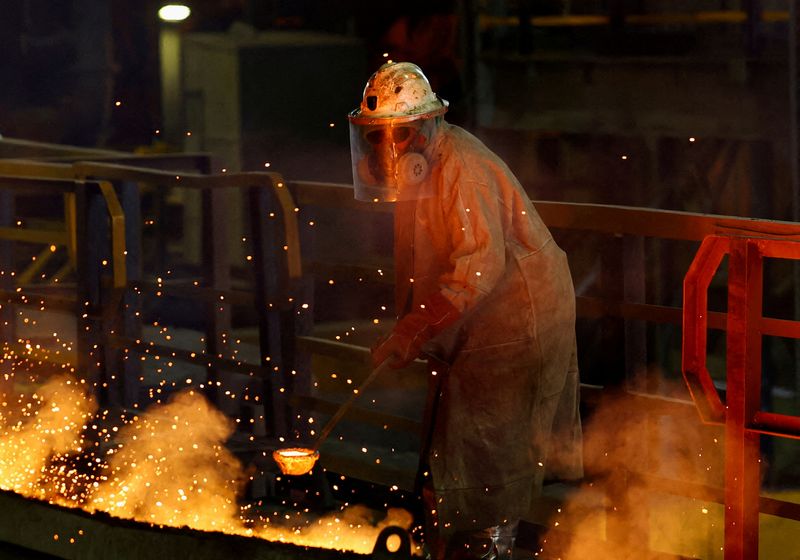By Eric Onstad and Polina Devitt
LONDON (Reuters) – A rise in hybrid car sales as electric vehicle adoption slows will provide an unexpected boost to demand for platinum group metals (PGMs) in coming years, similar to the longer lifespan now forecast for coal.
PGMs – mainly platinum and palladium – face a long-term structural decline in demand because they are mainly used for cleaning car exhausts, a process that is not necessary for pure EVs.
A few years ago, the outlook for PGMs and manufacturers like Anglo Platinum, Impala Platinum (OTC:) and Sibanye Stillwater (NYSE:) seemed bleak as EV sales soared and demand was expected to plummet. .
But slowing growth in electric car sales and rising demand for hybrid cars that require catalytic converters to combat pollution have given PGMs a new lease on life, which could put a floor under prices and keep some mines open longer can keep.
“You are still facing an outright drop in demand, but there is no immediate collapse, which could have been the prediction in some (previous) scenarios,” said Marcus Garvey, head of commodity strategy at Macquarie Bank in Singapore.
Global pure electric vehicle sales growth in the first half of 2024 slowed to 11% year-on-year, while plug-in hybrid (PHEV) sales rose 44%, according to consultancy Rho Motion.
For electric vehicles, the numbers are a big drop from two years ago, when sales shot up 77%.
Popular PHEVs include the Song from BYD (SZ:) and the BMW (ETR:) 3 Series.
Garvey said the PGM situation has some parallels with coal, which is being phased out as governments cut carbon emissions but will remain needed for years until more renewable energy is rolled out.
Weak PGM prices are currently limiting investment in production and if miners decide to close operations due to low profitability, prices could become volatile.
“The likelihood of the market becoming tighter than currently expected appears very high if we see any response from producers,” Garvey said.
HYBRID STRENGTH
The emergence of hybrids could last until 2030 or longer, extending the period in which PGMs are needed, analysts said.
“The shift to hybridization could be quite meaningful for the longer-term sustainability of the PGM industry,” says Wilma Swarts, director of PGMs at consultancy Metals Focus.
The weakness in EV sales means combined sales of petrol and hybrid cars, which were expected to remain flat last year, rose 9%, according to catalyst maker and PGM specialist. Johnson Matthey (LON:).
“This alone added 600,000 ounces to our estimates of automotive PGM demand,” it said in a report, adding that total automotive PGM demand rose 8% last year to 13.1 million ounces, the second highest total ever.
INCREASE OF PLUG-IN HYBRIDS
We see the greatest growth in PHEVs in China, where sales increased by 70% in the first half.
Consultancy Alix Partners has more than doubled its forecast for the global share of PHEVs from 5% two years ago to 12% in 2030.
“We have upgraded it considerably due to the developments of recent years,” says Gerrit Reepmeyer of Alix.
A survey by Alix this year found that in the world’s two largest car markets, the United States and China, more than 80% of consumers likely to buy an electric car would buy a PHEV rather than a pure electric car.
That could boost demand for PGMs, as PHEVs require about 10-15% more platinum metals than gasoline vehicles because engine pollution is higher when starting a cold engine, Swarts said. Gasoline engines in hybrids, especially PHEVs, are rarely used and therefore often start cold.
CHANGING RESOURCES
Analysts say the trend toward hybrids is expected to continue until EVs can compete globally with gasoline cars on price, batteries offer longer driving range and more charging stations are rolled out.
Many automakers are eager to shift resources to hybrids, which have higher margins than electric cars.
Last week, the world’s largest automaker Toyota (NYSE:) is said to have cut its EV production plans for 2026 by a third, while Sweden’s Volvo (OTC:) Cars has scrapped its target of being fully electric by 2030.
Ford (NYSE:), Toyota and Stellantis (NYSE:) have all beefed up their hybrid plans in recent months.
“Automakers are trying to find that sweet spot in terms of profitability, consumer acceptance and regulatory compliance,” Swarts said.
New U.S. auto emissions rules also boost the prospects for hybrids by allowing automakers to meet an EV mandate by producing more gas-electric hybrids.
The US and Canada have seen the biggest gains in sales of conventional hybrids, with a 33% increase in the first half of 2024.
Each additional million cars requiring catalytic converters will add about 150,000 ounces of PGM demand, Swarts said.
In China, where electric cars are already comparable in price to petrol cars, many consumers are opting for plug-in hybrids with a longer range. In such vehicles, the petrol engine is used exclusively for charging the battery, allowing longer driving distances.
NO HELP FOR NICKEL, COBALT
The shift to hybrids is expected to dampen demand for key battery materials such as cobalt and nickel, as hybrid batteries are smaller than those in electric vehicles.

According to consultancy CRU, the weighted average battery size for PHEVs for the first half of this year was 23.3 kilowatt hours (kWh), compared to 64.5 kWh for pure battery EVs (BEVs).
“The shift to PHEVs and the rollback of BEV targets are likely to have an overall negative impact on demand growth for battery materials in the coming years,” said Sam Adham, head of battery materials at CRU.

